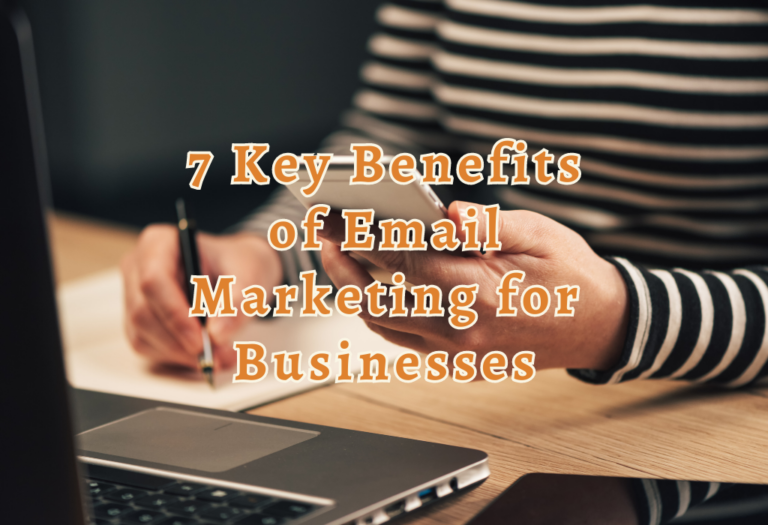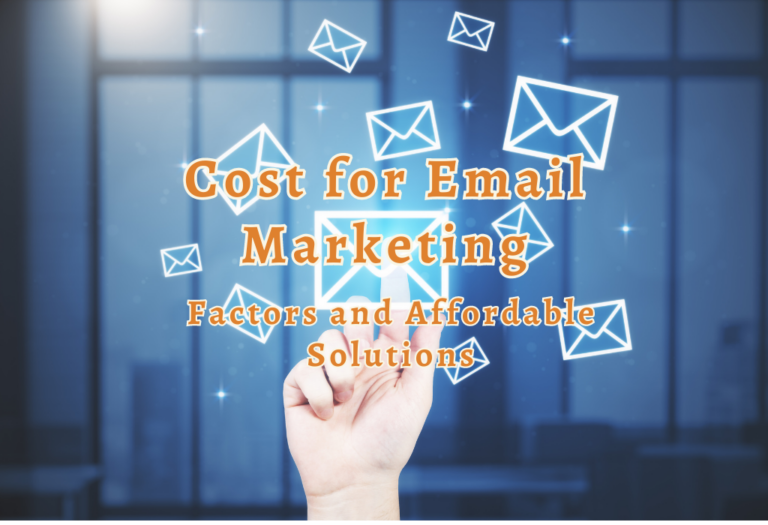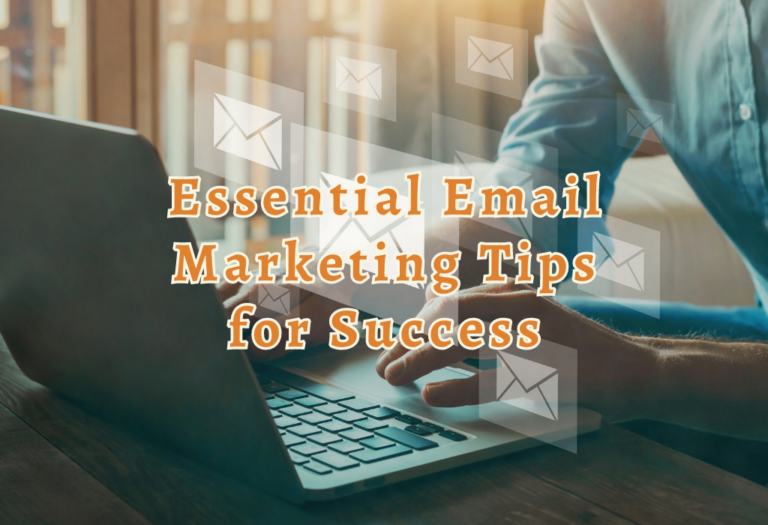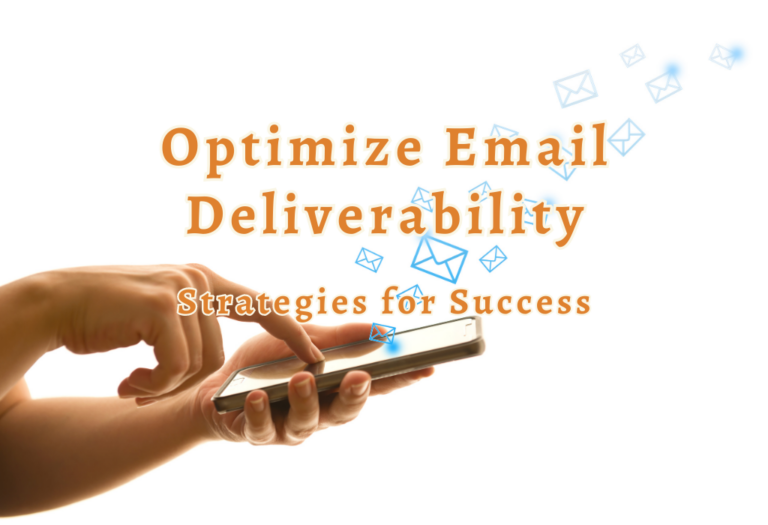As the year 2023 draws nearer, digital marketers are increasingly focused on finding the most effective email marketing tools and services. Starting to use email marketing software is an easy process. Typically, you’ll quickly determine whether or not you appreciate a product’s user interface (UI), and many of the options we assessed provide free trials so that you can explore before committing any money.
Fortunately, most of these services feature contemporary graphics and clean designs. Staying abreast of the latest trends and features that can help you reach your goals is essential in today’s rapidly changing email marketing landscape. In this comprehensive guide, we will explore some of the leading email marketing solutions available in 2023.
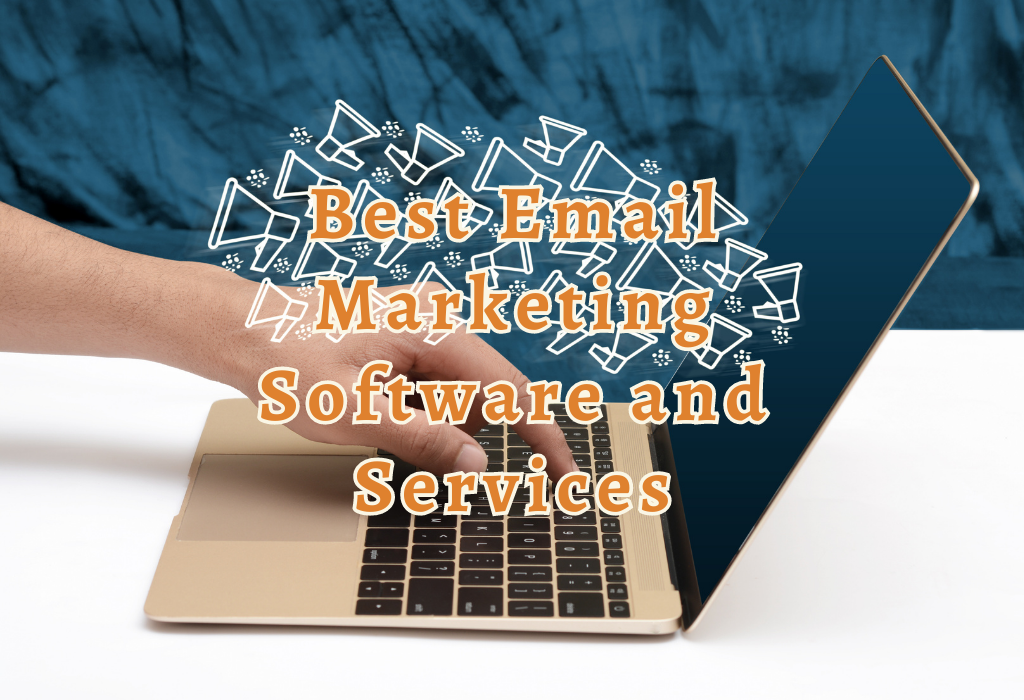
More Resources :
Top Email Marketing Platforms in 2023
In 2023, some of the top email marketing platforms include Salesforce Pardot, Campaigner, HubSpot Marketing Hub, Mailchimp, Sendinblue, and many more. These solutions cater to different business sizes and requirements while offering unique features tailored towards audience segmentation, personalized content, automation options, and more.
#2. Salesforce Pardot: Expensive but feature-rich for larger businesses
Salesforce Pardot is an advanced email marketing service offering a comprehensive tool suite designed specifically for large enterprises. While it may be pricier compared to other popular email marketing services, its extensive range of features such as lead scoring and nurturing make it worth considering if you’re looking for a robust solution.
The Benefits of Using Salesforce Pardot
#2. Campaigner: Customizable and competitively priced
Campaigner is known for its customizable templates allowing users to easily create professional-looking emails. This affordable email marketing service also includes powerful automation capabilities like triggered campaigns based on user behavior or events. It’s perfect for small-to-medium-sized businesses who want an easy-to-use platform without breaking the bank.
Integrations with Third-Party Software
Campaigner integrates seamlessly with an impressive menu of third-party software, including Salesforce, Shopify, and WordPress. This makes it easy to connect your email campaigns with other tools in your tech stack and streamline your workflow.
For example, if you use Salesforce as your CRM system, Campaigner can automatically sync contact information between the two platforms. You can also set up triggers so that certain actions in one system (such as adding a new lead) will trigger automated emails or workflows in the other.
A Powerful Workflow Designer
Campaigner’s workflow designer is another standout feature. With this tool, you can create complex automation sequences that respond to customer behavior or trigger based on specific dates or events.
User-Friendly Interface
In addition to its robust features and integration capabilities, Campaigner has an intuitive user interface that makes it easier than ever before to design beautiful emails quickly. The drag-and-drop editor allows users without coding experience to easily customize pre-designed templates according to their brand identity.
Pricing
Campaigner offers a range of pricing options based on the size of your email list and the features you need. Plans start at $19.95 per month for up to 1,000 contacts with unlimited emails and go up to custom enterprise-level solutions.
#3. HubSpot Marketing Hub: Comprehensive but steep learning curve
If you’re searching for an all-in-one email marketing platform with CRM integration capabilities, HubSpot Marketing Hub might be the right choice for you. This comprehensive solution offers a wide range of marketing tools, including email automation, lead management, and analytics. However, it has a steep learning curve due to its vast features.
#4. Mailchimp: Easy-to-use templates for small businesses
Mailchimp is one of the most well-known names in the email marketing space and is particularly popular among small businesses thanks to its user-friendly interface and attractive template designs. Creating stunning emails is a breeze with the vast array of pre-made templates and drag-and-drop capabilities.
#5. Sendinblue
If you’re looking for an all-in-one email marketing service that won’t break the bank, Sendinblue is worth considering. This platform has evolved from a basic email marketing package to a more comprehensive marketing hub with advanced automation capabilities and CRM features.
Advanced Automation Capabilities
One of the standout features of Sendinblue is its advanced automation capabilities. With this tool, you can create complex workflows that trigger based on user behavior or other actions. For example, if someone abandons their cart on your website, you can set up an automated workflow to send them a reminder email after 24 hours.
The platform also offers transactional emails which are triggered by specific events such as account creation or password reset requests. These types of emails have high open rates because they provide relevant information at just the right time.
CRM Features
In addition to its powerful automation tools, Sendinblue includes customer relationship management (CRM) features to help businesses manage their contacts and interactions with customers more effectively. You can store contact information in one place and track every interaction across different channels like social media and live chat.
Pricing
Perhaps most appealingly, Sendinblue’s pricing plans are very affordable compared to other popular email marketing services. A free plan is available for those who don’t need all the bells and whistles just yet.
Besides these top contenders in 2023’s email marketing landscape, there are several other noteworthy platforms such as ConvertKit, MailerLite, Klaviyo, AWeber, and ActiveCampaign. When choosing an email marketing platform, consider the features offered, ease-of-use, and overall performance.
Choosing the Right Email Marketing Service or Software
In 2023, selecting the best email marketing service or software for your business will be crucial to achieving success in this competitive space. When deciding which email marketing platform to use.
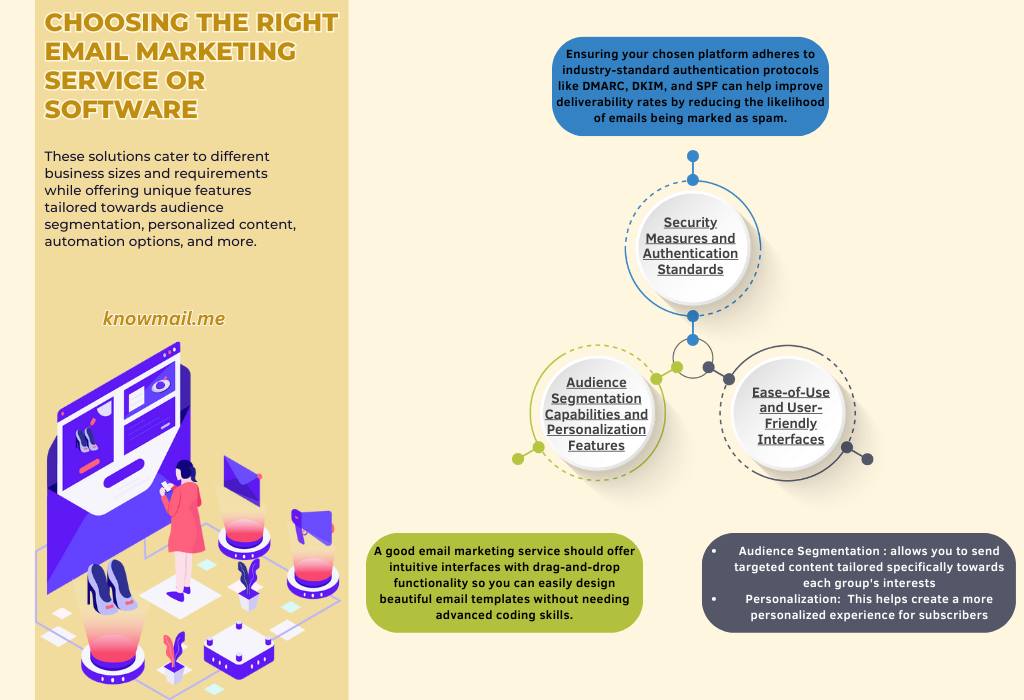
Security Measures and Authentication Standards
Email deliverability is a top concern for businesses relying on email campaigns to reach customers. Ensuring your chosen platform adheres to industry-standard authentication protocols like DMARC, DKIM, and SPF can help improve deliverability rates by reducing the likelihood of emails being marked as spam. Look for platforms that prioritize security features and provide regular updates on potential threats.
Ease-of-Use and User-Friendly Interfaces
A good email marketing service should offer intuitive interfaces with drag-and-drop functionality so you can easily design beautiful email templates without needing advanced coding skills. Additionally, look for services that provide templated workflows to automate timely emails based on customer actions or preferences. This saves time and helps ensure consistent messaging across all communication channels.
Audience Segmentation Capabilities and Personalization Features
When evaluating email marketing platforms, consider their ability to integrate seamlessly with other tools you’re already using in your business operations. For example, integration options like Zapier can help automate tasks between different applications – saving time and reducing manual data entry errors.
Effective Strategies for Higher Open Rates and Fewer Unsubscribes
Email campaigns should proactively build lists through lead magnets like e-books or webinars, segment user intent, and target content specific to subscriber groups, leading to higher open rates and fewer unsubscribes. Engaging readers at every step with recognizable from lines, catchy subject lines, preheader text that supports them, short punchy messages in emails themselves followed by CTAs helps drive click-throughs back to shopping pages and signup forms.
Building Lists Using Lead Magnets Such as E-Books or Webinars
To grow your email list effectively, consider offering valuable resources such as e-books or webinars in exchange for users’ contact information. This provides value to potential subscribers and ensures they are genuinely interested in the topics you cover. An ecommerce business dealing with eco-friendly items could present a complimentary manual on how to live sustainably.
Segmenting Users Based on Their Intent
Segmenting your email list based on factors such as demographics, purchase history, or engagement levels allows you to send more relevant content tailored towards each group’s needs and interests. Doing so increases the likelihood of users opening your emails and reduces the chances of them hitting unsubscribe due to irrelevant content.
Crafting Engaging Subject Lines
Creating engaging subject lines is crucial for grabbing your audience’s attention and increasing email open rates. Some tips to consider when crafting subject lines include:
- Keep it short: Aim for around 50 characters or less as many email clients truncate longer titles;
- Add personalization: Use the recipient’s name or other relevant information to make the message feel more tailored;
- Create a sense of urgency: Encourage users to act quickly with time-sensitive offers, deadlines, or limited-time promotions.
Measuring and Fine-Tuning Email Campaign Performance
By keeping tabs on metrics such as bounces, clicks, opens and unsubscribes, businesses can ascertain what resonates with their customers while experimenting with different components to gradually refine their messaging. By tracking key metrics such as bounces, clicks, opens, and unsubscribes, you can gauge what works best for your audience while A/B testing different elements helps improve messaging over time.
Tracking Important Email Performance Metrics
To ensure the success of your email marketing strategy, keep an eye on these critical metrics:
Utilizing A/B Testing to Optimize Content
A/B testing involves sending two slightly different versions of an email – version A and version B – to separate segments within your subscriber list. By comparing which version performs better regarding open rates or click-throughs, you can make data-driven decisions about optimizing future campaigns.
Some elements to consider testing include:
Improving Deliverability Through List Maintenance
Maintaining a clean email list is essential for ensuring the deliverability of your campaigns. Regularly scrubbing bounced emails from your lists helps improve overall performance, as sending to invalid addresses can harm your sender reputation.
Some best practices for maintaining a healthy email list include:
Transactional Emails vs Newsletters
In the world of email marketing, it is essential to understand the difference between transactional emails and newsletters. Both types of communications serve unique purposes, and tailoring your email marketing strategy accordingly can lead to more effective campaigns.
Purpose and Use Cases for Transactional Emails
Transactional emails are triggered by specific customer actions, such as online purchases or account updates. These messages often include order confirmations, shipping notifications, password resets, and other personalized information related to a user’s interaction with your business. Due to their nature, transactional emails typically have higher open rates compared to promotional content since they contain relevant details that recipients expect.
Benefits and Goals of Sending Newsletters
Email newsletters aim to share valuable information about your brand with subscribers while fostering long-term relationships through regular communication. This type of email usually contains news updates, product promotions, blog articles, or event announcements designed to engage readers over time.
Some benefits associated with sending well-crafted newsletters include:
Integrating Social Media into Your Email Marketing Strategy
In today’s digital landscape, it is essential for businesses to leverage multiple channels in order to reach a wider audience and increase engagement rates. One effective way of achieving this is by integrating social media into your email marketing strategy. By combining the power of both platforms, you can effectively communicate with your customers and prospects while also driving traffic back to your website or online store.
Using Pre-built Sign-up Pages for Social Media Platforms
To start integrating social media into your email marketing efforts, consider using pre-built sign-up pages on popular platforms like Facebook, Twitter, and LinkedIn. These pages allow users to easily subscribe to your mailing list without leaving their preferred platform. This not only streamlines the subscription process but also helps you grow your email list more efficiently.
Monitoring Campaign Performance Across Various Channels
Beyond collecting contact information from social media users, it’s crucial that you monitor the performance of both your email campaigns and social posts in tandem. Use analytics tools provided by each platform as well as third-party solutions like Sprout Social or Hootsuite to track key metrics such as open rates, click-through rates (CTR), shares, retweets, likes, and comments. These metrics will help gauge the success of your integrated marketing efforts.
Sharing Email Content on Social Media
In addition to using social media for list building and monitoring campaign performance, you can also repurpose your email content by sharing it directly on these platforms. Sharing your email content on social media can not only broaden the reach of your message, but also bring more visitors to your website or store. Here are some tips for effectively sharing email content on social media:
Taking advantage of both channels’ strengths will ultimately result in more effective communication with customers while maximizing ROI across all aspects of digital marketing endeavors.
FAQs about Best Email Marketing Software and Services (2023)
Conclusion
In conclusion, choosing the best email marketing software and services for your business in 2023 requires careful consideration of factors. There is a vast selection of email marketing solutions available, ranging from basic options to those with advanced automation capabilities. Some providers focus on enhancing their internal features, while others prioritize developing extensive partner and integration ecosystems. Regardless of the approach, email marketing remains a crucial foundation for any digital marketing strategy. Whether you’re seeking a straightforward solution or something more complex, one of the contenders we’ve reviewed should be an excellent fit for your needs. Sign up today to take your email marketing efforts to the next level with Knowmail’s AI-powered inbox assistant that helps you focus on what matters most in your inbox.

